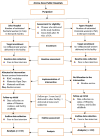Effectiveness of person-centered intervention on obstetric violence during facility-based childbirth among women who delivered in public hospitals in Southwest Ethiopia
- PMID: 40746675
- PMCID: PMC12310722
- DOI: 10.3389/fpubh.2025.1510430
Effectiveness of person-centered intervention on obstetric violence during facility-based childbirth among women who delivered in public hospitals in Southwest Ethiopia
Abstract
Background: Obstetric violence (OV) is a significant public health issue affecting reproductive health services and maternal health outcomes. Despite studies documenting its prevalence in Ethiopia, no experimental studies have assessed intervention effects. This study evaluates person-centered interventions for OV in public hospitals in Southwest Ethiopia, using an experimental design.
Methods: A quasi-experimental study was conducted in Southwest Ethiopia involving 396 women, divided into a control group (CG; n = 198) and an intervention group (IG; n = 198). The intervention group received person-centered interventions, including respectful maternity care workshops and maternal recognition certificates, while the control group received standard care. Statistical analyses included t-tests and regression to assess the intervention's impact on OV.
Results: The proportion of women who utilized companions during facility-based childbirth was higher in the intervention group [25.8%; 95% confidence interval (CI): 19.6, 31.9%] than in the control group (12.1%; 95% CI: 7.5, 16.7%). The proportion of women who experienced OV decreased significantly in the intervention group compared with the control group (IG: 42.05 ± 6.97; CG: 66.45 ± 12.12; p < 0.000), with a 26.00-point decrease in the experimental group. The multivariable general linear model revealed that the mean difference (MD) of non-confidential care (MD = -3.28; 95% CI: -3.66, -2.90), undignified care (MD = -7.03; 95% CI: -7.76, -6.31), non-consented care (MD = -5.64; 95% CI: -6.35, -4.92), physical abuse (MD = -4.80; 95% CI: -5.30, -4.31), discrimination (MD = -3.37; 95% CI: -3.79, -2.94), and detention (MD = -0.28; 95% CI: -0.51, -0.05) were significantly reduced in the intervention group, with effect sizes of 0.421, 0.480, 0.380, 0.479, 0.382, and 0.014, respectively. Women in the intervention group had an OV score that was, on average, 23 points lower (β = -23.42; 95% CI: -25.40, -21.44) than those in the control group. Additionally, women in the intervention group who had frequent contact with healthcare providers experienced, on average, a seven-point lower OV score (β = -7.47; 95% CI: -4.055, 18.37) than those in the control group.
Conclusion: This study revealed that implementing person-centered interventions through respectful maternity care workshops, maternity open days, and maternal certificates of recognition significantly decreases the incidence of OV and ultimately promotes respectful maternal care, improving maternal healthcare services.
Keywords: Ethiopia; childbirth; hospitals; obstetric violence; person-centered intervention.
Copyright © 2025 Taye and Belachew.
Conflict of interest statement
The authors declare that the research was conducted in the absence of any commercial or financial relationships that could be construed as a potential conflict of interest.
Figures


Similar articles
-
Effect of person-centered intervention on women's knowledge and attitude towards obstetric violence during facility childbirth in southwest Ethiopia: a quasi-experimental study.BMC Public Health. 2025 Apr 22;25(1):1475. doi: 10.1186/s12889-025-22734-z. BMC Public Health. 2025. PMID: 40264125 Free PMC article.
-
Debriefing interventions for the prevention of psychological trauma in women following childbirth.Cochrane Database Syst Rev. 2015 Apr 10;2015(4):CD007194. doi: 10.1002/14651858.CD007194.pub2. Cochrane Database Syst Rev. 2015. PMID: 25858181 Free PMC article.
-
Psychosocial interventions for supporting women to stop smoking in pregnancy.Cochrane Database Syst Rev. 2017 Feb 14;2(2):CD001055. doi: 10.1002/14651858.CD001055.pub5. Cochrane Database Syst Rev. 2017. PMID: 28196405 Free PMC article.
-
Hypnosis for pain management during labour and childbirth.Cochrane Database Syst Rev. 2016 May 19;2016(5):CD009356. doi: 10.1002/14651858.CD009356.pub3. Cochrane Database Syst Rev. 2016. PMID: 27192949 Free PMC article.
-
Assessment and support during early labour for improving birth outcomes.Cochrane Database Syst Rev. 2017 Apr 20;4(4):CD011516. doi: 10.1002/14651858.CD011516.pub2. Cochrane Database Syst Rev. 2017. PMID: 28426160 Free PMC article.
References
MeSH terms
LinkOut - more resources
Full Text Sources
Medical

